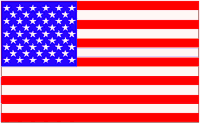Rules for Displaying the American Flag
It is the universal custom to display the flag only from sunrise to sunset
on buildings and on stationary flagstaffs in the open. However, when a patriotic
effect is desired, the flag may be displayed twenty-four hours a day if
properly illuminated during the hours of darkness.
No other flag or pennant should be placed above or, if on the same level,
to the right of the flag of the Unites States of America.
The flag should not be displayed on days when the weather is inclement,
except when an all-weather flag is displayed.
The flag, when flown at half-staff, should be first hoisted to the peak
for an instant and then lowered to the half-staff position. The flag should
be again raised to the peak before it is lowered for the day. By "half-staff" is meant lowering the flag to one-half the distance between the top and
bottom of the staff.
When the flag of the United States is displayed from a staff projecting
horizontally or at an angle from the window sill, balcony, or front of a
building, the union of the flag should be placed at the peak of the staff
unless the flag is at half-staff.
When the flag is displayed in a manner other than by being flown from a
staff, it should be displayed flat, whether indoors or out. When displayed
either horizontally or vertically against a wall, the union should be uppermost
and to the flag's own right, that is, to the observer's left. When displayed
in a window it should be displayed in the same way, that is with the union
or blue field to the left of the observer in the street. When festoons,
rosettes or drapings are desired, bunting of blue, white and red should
be used, but never the flag.
The flag should not be draped over the hood, top, sides, or back of a vehicle
or of a railroad train or boat. When the flag is displayed on a motorcar,
the staff shall be fixed firmly to the chassis or clamped to the right fender.
When the flag is displayed over the middle of the street, it should be suspended
vertically with the union to the north in an east and west street or to
the east in a north and south street.
The flag of the United States of America, when it is displayed with another
flag against a wall from crossed staffs, should be on the right, the flag's
own right, and its staff should be in front of the staff of the other flag.
The flag, when it is in such condition that it is no longer a fitting emblem
for display, should be destroyed in a dignified way, preferably by burning.
Flag Holidays
The Flag should especially be displayed on the following:
- New Year's Day, January 1
- Inauguration Day, January 20
- Lincoln's Birthday, February 12
- Washington's Birthday, third Monday in February
- Easter Sunday (variable)
- Mother's Day, second Sunday in May
- Armed Forces Day, third Saturday in May
- Memorial Day (half-staff until noon), the last Monday in May
- Flag Day, June 14
- Independence Day, July 4
- Labor Day, first Monday in September
- Constitution Day, September 17
- Columbus Day, second Monday in October
- Navy Day, October 27
- Veterans Day, November 11
- Thanksgiving Day, fourth Thursday in November
- Christmas Day, December 25
- Other days as may be proclaimed by the President of the United States
- Birthdays of States (date of admission)
- State holidays.
-
On the following days, the flag is to be flown at half-mast for the entire
day:
- May 15 - Peace Officers Memorial Day
- July 27 - Korean War Veterans Armistice Day
- December 7 - Pearl Harbor Day
The flag should fly at half-staff for 30 days at all federal buildings, grounds, and naval vessels throughout the United States and its territories and possessions after the death of the president or a former president.
Flag Locations
By Executive Order, the flag flies 24 hours a day at the following locations:
- The Betsy Ross House, Philadelphia, Pennsylvania
- The White House, Washington, D.C.
- US Capitol, Washington, DC
- Washington Monument, Washington, DC
- Iwo Jima Memorial to US Marines, Arlington, Virginia
- Battleground in Lexington, MA (site of first shots in the Revolutionary War)
- Winter encampment cabins, Valley Forge, Pennsylvania
- Fort McHenry, Baltimore, Maryland (a flag flying over Fort McHenry after a battle during the War of 1812 provided the inspiration for The Star-Spangled Banner
- The Star-Spangled Banner Flag House, Baltimore, Maryland (site where the famed flag over Fort McHenry was sewn)
- Jenny Wade House in Gettysburg, Pennsylvania (Jenny Wade was the only civilian killed at the battle of Gettysburg)
- U.S.S. Arizona Memorial, Pearl Harbor, Hawaii
- All custom points and points of entry into the United States
Flag Folding
Fold the flag in half width-wise twice. Fold up a triangle, starting at
the striped end ... and repeat ... until only the end of the union is exposed.
Then fold down the square into a triangle and tuck inside the folds.

Other Links:
Awareness Ribbons,
Flag Day,
Flags of the World,
Holidays,
U.S. States,
Flag Flying Quiz